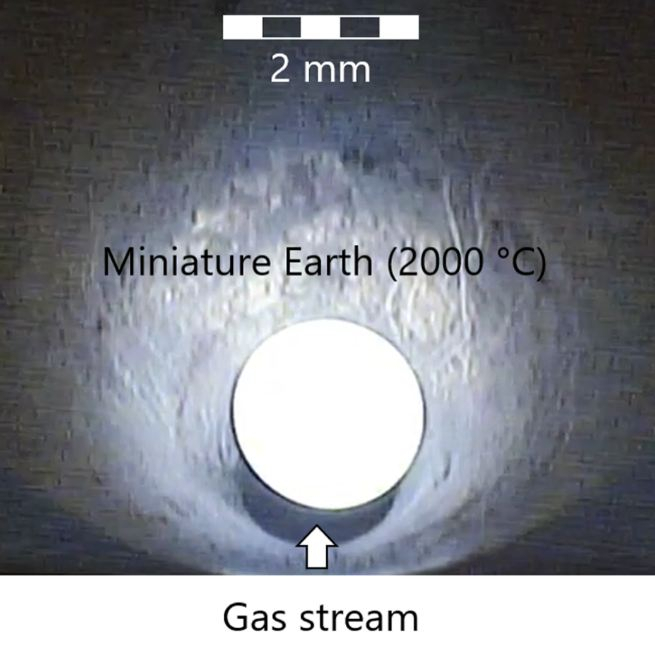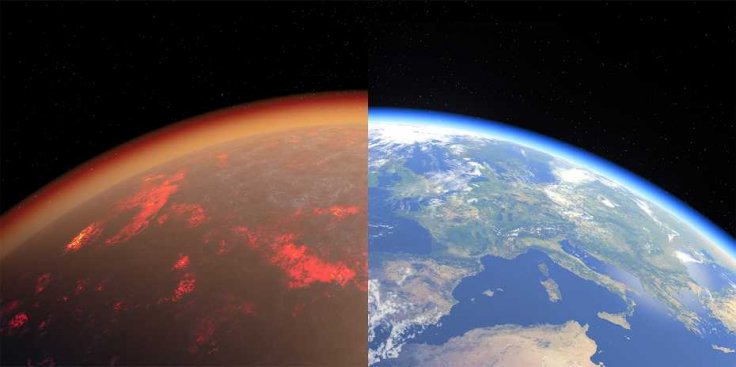The scientific community has been able to arrive at a consensus about what the surface of the Earth may have looked like 4.5 billion years ago—covered in hot molten magma. But the corresponding atmosphere has remained unclear. Now, researchers say that the atmosphere of Earth billions of years in the past was very similar to the present atmosphere of Venus.
In a new study, an international team of scientists attempted to glean what the atmosphere of Earth might have been numerous years ago by creating magma in the laboratory and exposing it to a varied mixture of gases. The results led the authors to deduce that 4.5 billion years ago, Earth's atmosphere would have resembled that of present-day Venus which is toxic and incapable of sustaining life.

Creating Magma In a Laboratory
Unlike the blue and lush planet that we know Earth as today, billions of years ago, our planet was characterized by volcanoes, volcanic eruptions, and rivers of magma that flowed across the surface. "Four-and-a-half billion years ago, the magma constantly exchanged gases with the overlying atmosphere. The air and the magma influenced each other. So, you can learn about one from the other," said Paolo Sossi, lead author of the study, in a statement.
To ascertain what the primordial atmosphere of Earth may have been, the authors created magma in the lab. They achieved this by blending powders that helped arrive at a composition similar to that of the molten mantle of Earth (the layer between the crust and the inner core). This mixture was heated to produce magma.

However, what sounds simple required advanced technology to accomplish. "The composition of our mantle-like powder made it difficult to melt - we needed very high temperatures of around 2,000° Celsius," said Sossi.
Modern Technology to Recreate The Past
In order to produce the magma, the scientists used a special furnace that utilized a laser for heating. The magma was made to levitate within the furnace by introducing streams of gas mixtures that flowed around it. The mixtures used were plausible composition of gases that could have interacted with magma 4.5 billion years ago. With every different mixture, the magma sample was influenced differently. Thus, the varied forms of magma were obtained.

The oxidation of iron (or rusting) when it comes in contact with oxygen is a known phenomenon. Rocks derived from the mantle contain iron in them. When the gas mixture that the scientists blew over their magma contained a lot of oxygen, the iron within the magma became more oxidized. "The key difference we looked for was how oxidized the iron within the magma became," noted Sossi.
According to Sossi, the level of oxidation of iron found in the cooled samples of magma could be compared to peridotites—naturally occurring rocks that the Earth's mantle is comprised of today. The levels of oxidation within these rocks continue to retain the influence of Earth's ancient atmosphere. Therefore, a comparison between the lab-produced and natural peridotites provided vital clues about the combination that had the closest proximity to our planet's pre-historic atmosphere.

More Like Venus and Less Like Earth
Sossi stated: "What we found was that, after cooling down from the magma state, the young Earth had an atmosphere that was slightly oxidising, with carbon dioxide as its main constituent, as well as nitrogen and some water." He added that at one hundred times that of today's, the surface pressure was significantly higher as well. Due to the hot surface, the atmosphere was also much higher. These attributes suggest that ancient Earth's atmosphere was similar to that of present-day Venus.

The results of the study led the team to draw two key conclusions. Firstly, Venus and Earth began with similar atmosphere. Due to its proximity to the Sun and the resulting higher temperatures, Venus was stripped of most of its water. However, Earth retained its water, mostly in the form of oceans, which absorbed most of the CO2 found in the air. This led to the reduction of the level of gases significantly.
Secondly, a widely popular theory explaining the emergence of life lost its likeliness. Known as the called "Miller-Urey experiment", it states that striking lightning reacts with some gases—specifically methane and ammonia—to result in the creation of building blocks of life, amino acids. However, this occurrence would have been highly unlikely as the gasses required for it were not available in necessary quantities.









